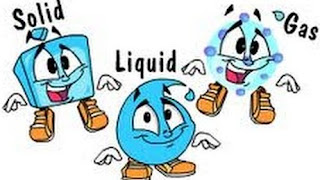Lesson Plan of Comparing Properties of Solids, Liquids & Gases General Science Grade IV
Lesson Plan of Comparing Properties of Solids, Liquids & Gases
General Science Grade IV
Students’ Learning Outcomes
·
Compare solids, liquids &
gases on the basis of shape and volume.
Information for Teachers
·
Solids have fixed shape and
fixed volume; liquids don’t have fixed shape but have fixed volume, while the
gases don’t have a fixed shape and fixed volume.
·
The three states of matter
can be explained with reference to water. Solid (ice) liquid (water) and gas
(water vapors or steam).
Material / Resources
Book, chair, pencil, jug containing water, cup,
register, rubber, glasses of different sizes, balloons having different shapes,
textbook
Worm up Activity
·
Show the students the
following things:
(Books, Chair, Pencil, Copy,
Table, Tree, Plate, School bag etc.
·
Ask students do these objects
have a fixed shape.
(Students’ response: Yes they
have fixed shape).
·
Can we identify a solid
through its fixed shape?
(Students’ response: Yes a
solid can be identified by its fixed shape)
·
Can we identify a solid
change its shape on its own?
(Students’ response: No, solids
don’t change their shape on their own)
v Does water has a fixed shape like a glass?
(Students’ response: No)
v Does water get the shape of the container in
which it is poured?
(Students’ response: Yes)
·
Tell the students that we
can’t see air, but we can feel its presence especially under a fan.
·
We can also feel the presence
of some gases by their smell and color.
·
Ask students what type of
smell they feel while passing along a sewage pond.
(Students’ response: bad
smell). This indicates bad smelling gases are coming out of the sewage pond.
Development
Activity 1
·
Place a book on a table and
draw a line around the book,
·
Shift the book on another
place.
·
Ask the following question
from students.
·
What does the space in
between the lines tell us?
(Students’ response: The
space between the lines is the space covered by the book)
·
Ask the students to take
different objects like a register, a rubber, a pencil and a glass on a paper
and draw lines around these objects. Ask the students the following questions.
v Do all these objects cover the same space?
(Students’ response: No, all these objects
cover different space according to their size)
Activity 2
·
Take about 250cm water in a
jug. Ask students to pour this water into four different vessels, as shown in
the following diagram)
·
Ask students what does this
activity show?
(Students’ response: This
activity shows that a liquid doesn’t have a fixed shape. It acquires the shape
of the vessel in which it is kept)
Activity 3
·
Take two glasses, of
different sizes. Fill the smaller glass with water. Now pour water from the
smaller glass into the bigger glass.
·
Did water completely fill the
bigger glass?
·
Water occupies all the space
of the smaller glass. It doesn’t fill all the space of the bigger glass. Ask students
why the bigger glass has not been filled? (Tell them that liquids have fixed
volume, they don’t occupy all the available space).
·
The amount of space that a
liquid takes up in an empty vessel depends upon the quantity of liquid poured
into that vessel. A fixed amount of liquid occupies a fixed volume.
Activity 4
·
The air inside a balloon has
taken the shape of that balloon.
·
Ask students, does the air
have fixed shape like solid things?
(Students’ response: No).
·
Spray a little perfume on one
side of the room and wait for some time.
·
Ask students sitting at the
other end of the room if they can smell the perfume.
·
Ask the students, do the vapors of the perfume remain at a certain place.
(Students’ response: No, the vapors have occupied all the available space)
Sum up / Conclusion
·
All the solid objects have a
fixed shape. They also cover a fixed space.
·
Liquids occupy definite
volume but they don’t have fixed shape. They take the shape of the container in
which they are kept.
·
Gases don’t have fixed shape.
Like liquids they acquire the shape of the vessel in which they are kept. A glass
acquires all the space present in a vessel.
Assessment
·
Ask the students following
questions:
v What will happen if you release air present I a
cycle tube within a room?
(Students’ response: Air will spread throughout
the room)
v Transfer tea prepared in a tea pot to a cup,
saucer and a glass. From this experiment what do you conclude about the shape
of the liquid tea?
(Students’ response: Being a liquid, tea doesn’t
have a fixed shape)
v Show students some coins and ask: What is the
shape of coins? Can they change their shape while moving from one hand to
another?
(Students’ response: No, being solids, coins
don’t change their shape while moving from one hand to another)
v Which state of matter occupies all the
available space?
(Students’ response: A gas occupies all the
available space).
Follow up
·
Make a table given on next
page on the board and ask the students to copy on their note books.
·
Ask them to complete the
table.








Comments
Post a Comment